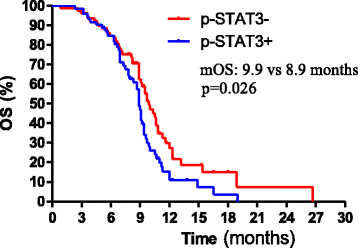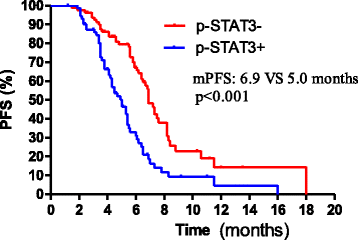Expression of activated signal transducer and activator of transcription-3 as a predictive and prognostic marker in advanced esophageal squamous cell carcinoma
- PMID: 26553224
- PMCID: PMC4640156
- DOI: 10.1186/s12957-015-0726-z
Expression of activated signal transducer and activator of transcription-3 as a predictive and prognostic marker in advanced esophageal squamous cell carcinoma
Abstract
Background: Signal transducer and activator of transcription-3 (STAT3) is an oncogenic transcription factor constitutively active and aberrantly expressed in various types of malignancies, and the expression of p-STAT3 has been recognized as a predictor of poor survival. It remains unclear how variations in p-STAT3 expression influence clinical outcomes in esophageal squamous cell carcinoma (ESCC).
Methods: Between 1 January 2008 and 1 November 2013, 153 advanced esophageal squamous cell carcinoma patients (stage IV) from two cancer centers in West China were treated with paclitaxel and cisplatin. We retrospectively analyzed the clinical outcomes of patients with ESCC and examined the correlation between p-STAT3 levels and clinical outcomes in esophageal cancer patients.
Results: Among the 153 patients, positive p-STAT3 expression was observed in 73 of 153 (47.7 %) cases. The median PFS for patients with positive expression of p-STAT3 and negative expression of p-STAT3 was 5.0 months and 6.9 months, respectively (P < 0.001). The median overall survival was significantly higher in patients with p-STAT3 negative tumors than in those with p-STAT3 positive tumors (9.9 vs 8.9 months, P = 0.026). Kaplan-Meier survival analysis showed that p-STAT3 expression was statistically indicative of a poor prognosis for progression-free survival.
Conclusions: These data showed that p-STAT3 expression was significantly associated with poor prognosis in patients with esophageal cancer and could be used as a predictive and prognostic marker in esophageal cancer.
Figures



Similar articles
-
Dual high expression of STAT3 and cyclinD1 is associated with poor prognosis after curative resection of esophageal squamous cell carcinoma.Int J Clin Exp Pathol. 2014 Oct 15;7(11):7989-98. eCollection 2014. Int J Clin Exp Pathol. 2014. PMID: 25550842 Free PMC article.
-
A retrospective clinical study of comparing paclitaxel plus S-1 versus paclitaxel plus cisplatin as the first-line treatment for patients with advanced esophageal squamous cell carcinoma.Oncotarget. 2017 Jan 31;8(5):7540-7547. doi: 10.18632/oncotarget.13602. Oncotarget. 2017. PMID: 27902478 Free PMC article.
-
Prognostic values of STAT3 and HIF-1α in esophageal squamous cell carcinoma.Eur Rev Med Pharmacol Sci. 2019 Apr;23(8):3351-3357. doi: 10.26355/eurrev_201904_17698. Eur Rev Med Pharmacol Sci. 2019. PMID: 31081089
-
Molecular interplay of pro-inflammatory transcription factors and non-coding RNAs in esophageal squamous cell carcinoma.Tumour Biol. 2017 Jun;39(6):1010428317705760. doi: 10.1177/1010428317705760. Tumour Biol. 2017. PMID: 28618941 Review.
-
Obstructive Esophageal Cancers at Endoscopy Are Associated with Reduced Survival and Poor Outcome.Isr Med Assoc J. 2023 May;25(5):328-331. Isr Med Assoc J. 2023. PMID: 37245096 Review.
Cited by
-
STAT3β Enhances Sensitivity to Concurrent Chemoradiotherapy by Inducing Cellular Necroptosis in Esophageal Squamous Cell Carcinoma.Cancers (Basel). 2021 Feb 21;13(4):901. doi: 10.3390/cancers13040901. Cancers (Basel). 2021. PMID: 33670049 Free PMC article.
-
PI3K/AKT inhibition induces compensatory activation of the MET/STAT3 pathway in non-small cell lung cancer.Oncol Lett. 2018 Jun;15(6):9655-9662. doi: 10.3892/ol.2018.8587. Epub 2018 Apr 26. Oncol Lett. 2018. PMID: 29928341 Free PMC article.
-
Niclosamide inhibits the cell proliferation and enhances the responsiveness of esophageal cancer cells to chemotherapeutic agents.Oncol Rep. 2020 Feb;43(2):549-561. doi: 10.3892/or.2019.7449. Epub 2019 Dec 27. Oncol Rep. 2020. PMID: 31894334 Free PMC article.
-
Metformin inhibits esophageal squamous cell carcinoma-induced angiogenesis by suppressing JAK/STAT3 signaling pathway.Oncotarget. 2017 Aug 18;8(43):74673-74687. doi: 10.18632/oncotarget.20341. eCollection 2017 Sep 26. Oncotarget. 2017. PMID: 29088816 Free PMC article.
-
Activated STAT3 Could Reduce Survival in Patients with Esophageal Squamous Cell Carcinoma by Up-regulating VEGF and Cyclin D1 Expression.J Cancer. 2020 Jan 20;11(7):1859-1868. doi: 10.7150/jca.38798. eCollection 2020. J Cancer. 2020. PMID: 32194797 Free PMC article.
References
-
- Chen M-F, Chen P-T, Lu MS, et al. IL-6 expression predicts treatment response and outcome in squamous cell carcinoma of the esophagus. Mol Cancer. Huo YQ1, Ruan X, DU XL, Shang L, Cai Y, Xu X, et al. Overexpression of p-Stat3 and Mcl-1, and their correlation with differentiation and apoptotic resistance in esophageal squamous cell carcinoma. Zhonghua Zhong Liu Za Zhi. 2013;35:579–84. - PubMed
MeSH terms
Substances
LinkOut - more resources
Full Text Sources
Other Literature Sources
Medical
Miscellaneous

